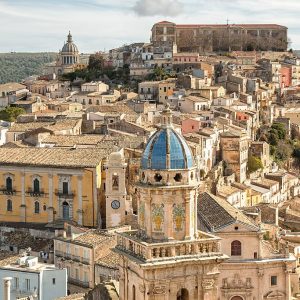Andrea Camilleri would have turned one hundred today, 6th September 1925, born in Porto Empedocle, Sicily. His name is synonymous with Inspector Salvo Montalbano, but to regard him merely as a crime writer is to diminish a vast, multifaceted literary legacy.
Camilleri began his creative life not as a novelist, but as a theatrical playwright and director. At Rome’s Silvio D’Amico Academy, he immersed himself in the works of Pirandello, Beckett, and Brecht, and later directed for RAI, learning the rhythms of dialogue and drama in adaptations of Maigret and other classics.
Only in his sixties did he turn to prose, and in doing so entered a late-life renaissance. Over 100 books followed, spanning historical novels, essays, children’s stories, and the celebrated Montalbano series. His work has sold upwards of 25 million copies, translated into more than 120 languages.
Camilleri always wrote with structure and precision. “All the novels of Montalbano are composed of 180 pages… divided into 18 chapters of 10 pages each. If the novel ends with even a page too many or too few, I rewrite it,” he once confessed, a revealing glimpse into his meticulous, geometrical method.
Yet within this structure flowed a voice deeply rooted in human warmth and Sicilian spontaneity. “Montalbano felt moved. This was real friendship, Sicilian friendship, the kind based on intuition, on what was left unsaid. With a true friend, one never needs to ask, because the other understands on his own accordingly,” Camilleri wrote, a line that is quiet, and yet so resonant, defining the emotional subtlety of his stories.
For Camilleri, Sicily was never a mere setting, it was character, culture, and conscience. “Sicily has suffered 13 foreign dominations from which she has taken both the best and the worst. The sequence of different cultures has made Sicily a fascinating place, quite unlike any other,” he observed. And Camilleri layered that beauty and complexity in every story.
Sicily through Camilleri’s eyes
Though his work ranged widely, it was Inspector Montalbano, the gruff, gourmet detective of Vigàta, who created a vivid gateway into Camilleri’s Sicily. Through 28 novels, the detective confronted Mafia ties, political corruption, and human tragedy, yet always beneath it all there was humour, food, landscape, and that touch of hope. “I deliberately decided to smuggle into a detective novel a critical commentary on my times,” said Camilleri, making clear that beneath the murder puzzle lay social conscience.
The television adaptation beginning in 1999 magnified this world, unveiling Sicily’s baroque towns, luminous coastline, and weathered architecture to audiences worldwide. For travellers, these are not fictional landscapes but vibrant places you can walk, taste, and feel.
Montalbano locations






In Scicli, the town hall stands in for Montalbano’s Vigàta precinct. The facades, the quiet streets, the inevitable presence of Catarella’s comic missteps anchoring a scene, all this feels lived-in rather than staged. Scicli has a presence so vivid that one senses the inspector’s Fiat rounding the corner at any moment, a subtle suggestion of fiction breathing with life.
Down the valley lies Modica, rising in tiers to the Duomo di San Giorgio. Its monumental staircase, scented with jasmine and bougainvillea, is not just a setting but a slow ascent into memory. Beneath its baroque splendour runs a gritty undercurrent: Modica chocolate, made in ancient style, grainy with history and sweetness. Here, food becomes metaphor – a way to taste Sicily’s complexity.
Noto is a town of luminous facades and balanced baroque urbanity, appears in many episodes. There’s an irony in how elegance frames darkness in Montalbano’s cases; but walking Corso Vittorio Emanuele you feel only calm. Here Camilleri’s skill was to let beauty hold its ground even as drama unfolded.
On the coast, Punta Secca becomes Marinella. Montalbano’s terrace, sea-washed and salt-scented, is a pilgrim site for fans but off-season, it returns to slumber, ordinary and evocative. Nearby Sampieri’s abandoned factory, used for scenes of tension or crime, shows the wilder, post-industrial face of the island.
Finally, Agrigento, Camilleri’s birthplace, frames Sicily’s ancient heritage in the Valley of the Temples. With the city dubbed Italy’s Capital of Culture in 2025, the Greek ruins and Camilleri’s own narrative form a dialogue across the centuries.
The Sicilian voice
Camilleri’s voice was meticulous yet lyrical, a hybrid of Italian and Sicilian dialect crafted for fidelity to speech and character. “I could not tell a story if I did not immerse it in a precise historic-geographic context… my writing gains strength when I express myself in dialect,” he explained.
In his fiction, food is not detail but rhythm. The language around meals, whether cannoli or pasta, evokes place, memory, tradition. “As they ate, they spoke of eating, as always happens in Italy,” he noted.
Camilleri’s method, measured, ordered, mapped like geometry with peaks and intervals, grounded his whimsical imagination in discipline. Without such structure, he said, he could not write.
An island legacy
Camilleri passed away in 2019, aged 93. His centenary is a reminder that literature preserves place as much as plot. Visiting Sicilian towns featured in his work – Scicli, Modica, Noto, Punta Secca, Agrigento – is to walk within layers of fiction and authenticity intertwined.
Throughout 2025, Italy is marking Camilleri’s centenary with tributes which reflect his depth and diversity. In Taormina, performances at the ancient theatre echo with Camilleri’s theatrical roots. In Rome, Casa del Cinema is screening Conversazione su Tiresia, his final one-man play, while the Auditorium Parco della Musica hosts Andrea Camilleri: Birth of a Legend, where readings and music converge in tribute. A literary prize in his name and exhibitions like Scenes, Voices, Accents, Writings continue to bring new voices into dialogue with his legacy.





